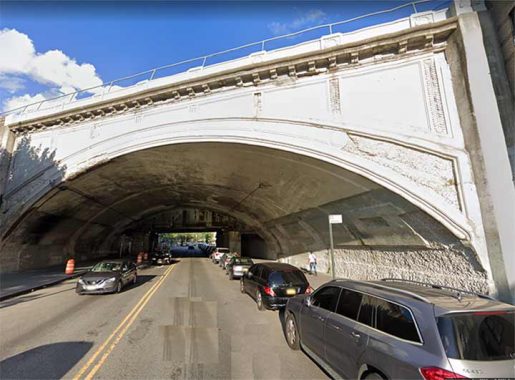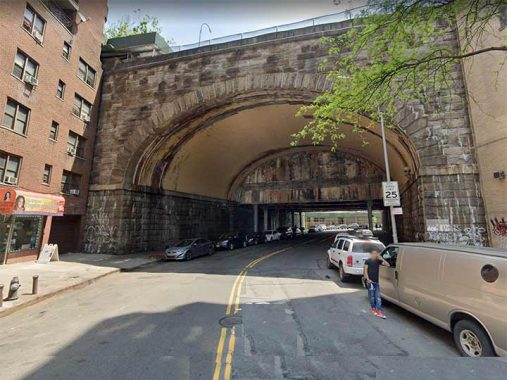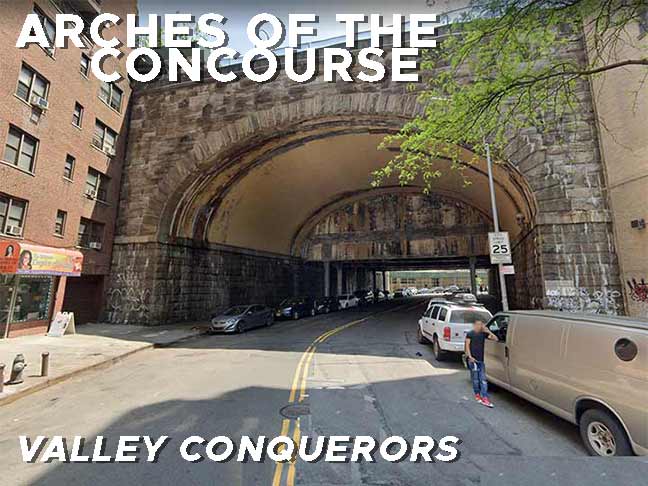
I am a fan of infrastructural elements in street layouts that aren’t shown on maps and consequently, I was unaware of until I bumped into them myself when out for jaunts. As Forgotten fans know if you have been reading this any length of time, I’m a big fan of the masonry arches that carry train tracks over the streets of Astoria en route to the Hell Gate Bridge: there’s really nothing else exactly like them in any other part of town.
That’s not to say, though, that there aren’t surprising masonry arches to be found. I have known about the one that takes Seeley Street over Prospect Avenue in Windsor Terrace for a long time. And, I have been aware of the ones I’m featuring today, in the Mount Eden section in the Bronx, since I first walked the Grand Concourse in 1999.
As a little background info on the “Conk” let me quote from one of FNY’s features from 2011:
Eleven lanes wide from 161st Street north to Mosholu, the Grand Boulevard and Concourse (shortened to Grand Concourse for the benefit of sign makers and cabbies) was built, from 161st Street north, in 1909 by engineer Louis Risse. In 1927, it absorbed Mott Avenue, which ran from 138th north to 161st, and the older street was widened. The Grand Concourse became the Bronx’s showpiece as the Bronx County Courthouse, Yankee Stadium, and an array of elegant apartment buildings were constructed along its length. The Concourse and surrounding streets are a wonderworld of magnificent apartment architecture. Most of the grand apartments were built from 1925-1940. The dominant style is Art Moderne, a streamlined style offshot from Art Deco. In that era most of the Concourse’ residents were Eastern European and Jewish, but in the late 1960s and early 1970s demographics changed, as Co-Op City near the Westchester county line was built and the overall rush to surburbia spurred a move out of the city. Today the Concourse is home to a Latino and Caribbean-American population, and the architecture is seemingly eternal.
The Concourse occupies a lengthy ridge in the southwest Bronx, which gave engineer Risse an opportunity to innovate. Major east-west roads that were already established, like Tremont Avenue and Burnside Avenue, were placed in underpasses under the Concourse, while in other cases, the Concourse itself moves under the cross road, as it does at Fordham Road. Goods were much more easily transported without the logjams and traffic tie ups that such divisions made possible (in the Concourse’s early days, at least). Major schools relocated their campuses nearer the great road. Yankee Stadium was built a block away in 1923 and great hotels accompanied it — visiting clubs, as well as a few Yankees, stayed at the Concourse Plaza Hotel.
Risse (1850-1925) first envisioned the Concourse in the 1870s, when he was in his twenties. He lived to see a scaled-down version of the road become a reality. In the 1870s, the auto was still science fiction, and Risse’s vision encompassed horse drawn carriages pleasantly clomping up and down tree-lined, shady express route (much like Olmsted and Vaux’ original plans for Ocean and Eastern Parkways in Brooklyn). Detailed plans were drawn up in 1892 with the aid of Louis J. Heintz, who died at age 31 and did not see the plans realized, and Louis F. Haffen, who after succeeding Heintz as Commissioner of Street Improvements, oversaw the Concourse’s construction from 1902 to 1909 as Borough President. Remember, at the same time, the IRT subway, then under private ownership, was beginning to tunnel lines and stretch els from the heart of Manhattan to the Bronx and Brooklyn as well, and it was the beginning of a grand era of road building that would continue through most of the 20th Century under the guidance, some say dictatorship, of NYC road czar Robert Moses, who rose to prominence in the LaGuardia era. It was also the beginning of an amazing era of public transportation construction. Observing in the early 2010s, we can only marvel at the pace on which these great public works were constructed one century ago.

What I haven’t taken note of till now are a pair of magnificent arch bridges that take the Concourse above West 174th and 175th Streets, with the Cross-Bronx Expressway slotted in between the two. When Risse and company were plotting the Concourse, they had to deal with a deep valley in Mount Eden. Instead of building steep grades to get down the trench and then back up, they bridged the Concourse above it in two spots to match the topography, hence the bridge.
In this shot we see East 174th Street east of Walton Avenue, with the Grand Concourse bridged above. if you walk a bit further in…

…notice that the East 174th-175th Street station serving the B and D trains of the IND Concourse Line can be accessed here at the south end of the station.
While the original arch was completed in 1909, when the IND was built in the 1930s, the subway actually had to be bridged above the street. This is a rare case of a subway running in a bridge; another can be found in Bay Ridge, where the BMT 4th Avenue Line (R) is bridged above the Bay Ridge freight LIRR line.

Meanwhile, north of here, past the Cross-Bronx, West 175th was placed below the Concourse on a masonry bridge of a completely different design. Risse didn’t have to do that; he could have made the two arches the same design, even though this arch is higher than the other one. On the other side of the arch, West 175th becomes Morris Avenue.

The most unusual thing about the East 174th-175th Street station is that until recently it had unique entrances, with nonstandard fencing and lighting. And not least, the exit was on the Concourse, not on West 175th Street way below. When I passed by in 1999, it was in the decrepit condition seen here.

By 2016, the entrance was the same although repainted and equipped with new “half moon” station indicator lamps.

In 2018 East 174th-175th was one of the stations, along with several on the 4th Avenue BMT, 6th Avenue IND and BMT Astoria Line to received station makeovers. I have detailed these with my post about 53rd Street in Brooklyn. I’m unsure if all the station improvements I listed there were made here, but a consequence was the elimination of the nonstandard entrance above the Cross-Bronx Expressway.

One element of the 175th Street arch that was kept is this frieze with the names of the Concourse’s engineers. However, this relatively low railing now has a chain link fence in front of it, likely to prevent the local youth from tossing objects onto the expressway below.
As always, “comment…as you see fit.” I earn a small payment when you click on any ad on the site.
11/15/21


7 comments
I was involved with the 2004 attempt to rebuild the Seeley St overpass. Community fought against it and won its cancellation, partly because project included lowering Prospect Ave roadbed that could have allowed for unwanted truck traffic. It was assumed that when overpass deteriorated in future that it would just be closed and creating dead ends on both sides.
The D train stop at 174-175th Streets and the Grand Concourse is unique because passengers can enter the station by going up (from the two cross streets) or down (from the Concourse itself). There’s no other station exactly like it, especially the large arches that encompass the subway tunnel. My wife grew up at this exact location but never realized how unusual this station was until after she moved away.
Two other IND stations along the Concourse at 167th and 170th Streets also bridge the cross street underpass, but now the only station entrances at those two stations are traditional downward stairs on the Concourse (upper) level. Stairs to the lower (underpass) level were closed years ago due to security concerns – at one time those stairs provided access to crosstown bus and trolley routes that used the underpasses.
Oh man. Grew up from my late teenager years up to my late 20s here in Mount Eden and Monroe Aves. Moved out less than six months ago so it makes me feel happy to see my local subway station on the FNY profile. My nerdy self could never get over the amazing engineering work undertaken to stack the Cross-Bronx, E174, IND subway line and the Grand Concourse on top of each other. Truly amazing. Only blocks away a similar complex situation arises with the Jerome Avenue EL.
They city should mantain those underpasses a bit more before we lose them. Over the years I noticed many leaks filtering from the Grand Concourse to the arched underpasses. Im not sure what can be done to stop water at this point but it would be a shame for them to end up having to replace the whole thing later on
Think you FNY. Long live the Bronx and NYC
Thank you for your article. I grew up on 175th and Walton. I saw and walked under that underpass every day. I recognized it immediately! We used to call it the tunnel.
I was not aware that the entrances to the subway at 175th street was unique. How interesting. Although I moved away from there many years ago, I remember it well.
Hey Andy
The other place on the Grand Concourse where you can enter from ABOVE and BELOW the subway is Kingsbridge Road, southern end of the station.
I have lived in The Bronx my entire life and never heard the Grand Concourse called the ‘Conc’.
To me, friends and family, it always is, was and will be ‘The Concourse’ although I will occasionally say Grand Concourse if the conversation warrants it.
A friend sent me these pictures several years ago, but looked at them again in 2024. I get teary just looking at these pictures, as I lived across the street from the “tunnel” on 174th Street and Selwyn Avenue. There is a very clear picture of my building 1706 Selwyn Avenue on one of the view from the Concourse overlooking the Cross Bronx Expressway (which totally destroyed out beautiful neighborhood) and the bedroom that I used to look out of. What a wonderful time to have grown up in the 1940’s. My sister and I used to walk to my grandmother’s house through the other “tunnel” and past the garages on Morris Avenue and it was very spooky to us because there were very few cars there at the time. Wonderful memories!!!